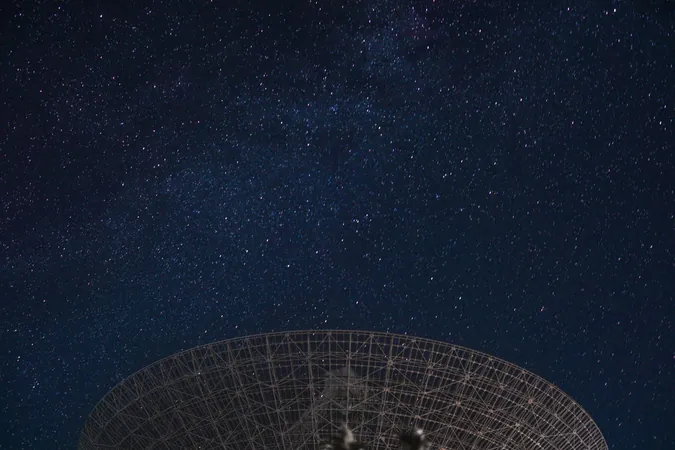
Major Breakthrough: Astronomers Discover the Exact Origin of a Fast Radio Burst!
2025-01-01
Author: Sarah
Fast Radio Bursts (FRBs) are mysterious cosmic phenomena, defined by brief but intense explosions of radio waves produced by incredibly dense astronomical objects like neutron stars and possibly black holes. These celestial fireworks last for a mere millisecond but unleash energy equivalent to that of entire galaxies—an astonishing display of cosmic power.
First uncovered in 2007, FRBs have captivated astronomers, and since then, thousands have been detected, ranging from our own Milky Way to galaxies over 8 billion light-years away. Despite the frequency of these events, the precise mechanics behind their creation have remained a hot topic among scientists.
However, groundbreaking research from astronomers at MIT has made a significant leap in understanding these phenomena by pinpointing the origin of one specific FRB, designated FRB 20221022A. This particular burst was detected from a galaxy around 200 million light-years away—a remarkable cosmic distance.
By employing a novel technique involving the analysis of the burst's "scintillation"—the effect that makes stars appear to twinkle—the researchers were able to deduce more about its source. They found that the FRB likely originated close to its neutron star source, at a maximum distance of about 10,000 kilometers. To provide context, that's just a fraction of the distance between New York and Singapore.
The proximity to the neutron star suggests the signal was generated within the star's magnetosphere—a zone of extreme magnetic influence surrounding the compact star. This pivotal discovery marks the first conclusive indication that FRBs can arise from such turbulent magnetic environments.
Lead author Kenzie Nimmo explains, “In these environments around neutron stars, the magnetic fields reach the limits of what the universe can produce. The energy stored in these fields is twisting and reconfiguring, ultimately releasing radio waves that we can detect from vast distances.”
Adding to the intrigue, Kiyoshi Masui, an associate professor of physics at MIT, states that around these magnetically charged neutron stars, atoms cannot exist as they would be torn apart by the intense magnetic forces.
Detection of FRBs has drastically increased in recent years, spurred by the Canadian Hydrogen Intensity Mapping Experiment (CHIME). Since 2020, CHIME has successfully recorded thousands of these bursts from across the universe. While the scientific community largely agrees that FRBs originate from extremely compact objects, their driving physics remain shrouded in uncertainty.
Several models have been proposed regarding the origin of these bursts, with some suggesting they come from the tumultuous magnetosphere surrounding compact objects, while others posit they originate from shockwaves emitted far from the source itself. The MIT researchers employed the concept of scintillation to investigate this.
By studying FRB 20221022A, they confirmed that it showcased notable scintillation, reinforcing its close proximity to a neutron star. Their findings demonstrate that the signal's light, which exhibited a varied polarization signature, hints at being produced in the immediate environment of the neutron star, reminiscent of characteristics found in pulsars.
The team explained that the scintillation effect observed can act as a cosmic lens, enabling researchers to estimate that the FRB originated from an extraordinarily limited region, within 10,000 kilometers of the neutron star.
"This precision is akin to measuring the width of a DNA helix—approximately 2 nanometers—while standing on the moon," notes Masui.
Remarkably, this research invalidates the theory that FRB 20221022A emitted from the outskirts of a compact object. Instead, it confirms that FRBs can erupt from very near neutron stars, underscoring the chaotic and complex magnetic dynamics at play.
With CHIME detecting several FRBs daily, the scientists speculate that the variations in these bursts signal diverse origins and mechanisms at work. The scintillation technique they developed will be invaluable in further dissecting the intricate physics that govern these enigmatic cosmic occurrences.
Could this discovery unlock the secrets behind one of the universe’s most bewildering phenomena? Only time will tell as researchers continue to explore the depths of our cosmos! Stay tuned for more thrilling cosmic revelations!

 Brasil (PT)
Brasil (PT)
 Canada (EN)
Canada (EN)
 Chile (ES)
Chile (ES)
 Česko (CS)
Česko (CS)
 대한민국 (KO)
대한민국 (KO)
 España (ES)
España (ES)
 France (FR)
France (FR)
 Hong Kong (EN)
Hong Kong (EN)
 Italia (IT)
Italia (IT)
 日本 (JA)
日本 (JA)
 Magyarország (HU)
Magyarország (HU)
 Norge (NO)
Norge (NO)
 Polska (PL)
Polska (PL)
 Schweiz (DE)
Schweiz (DE)
 Singapore (EN)
Singapore (EN)
 Sverige (SV)
Sverige (SV)
 Suomi (FI)
Suomi (FI)
 Türkiye (TR)
Türkiye (TR)
 الإمارات العربية المتحدة (AR)
الإمارات العربية المتحدة (AR)